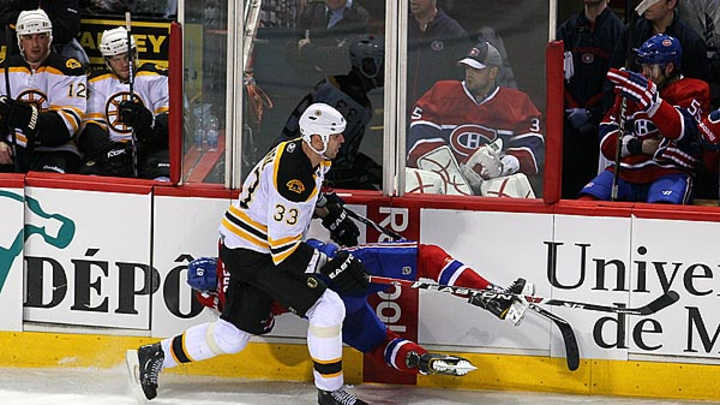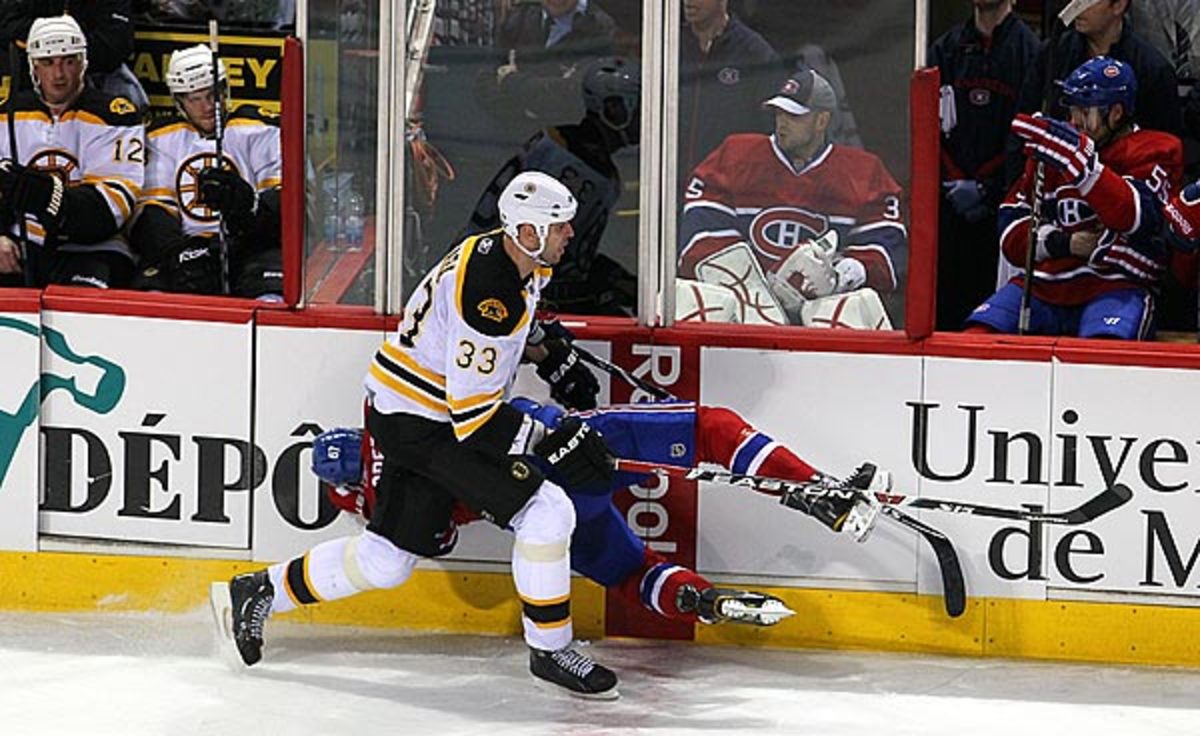NHLers question league's violence limits

As NHL players wonder why Zdeno Chara was allowed to escape suspension for his hit on Max Pacioretty, some people see arena safety as a main issue this incident. (Jean-Yves Ahern/Icon SMI)

By Stu Hackel
Thursday's Canucks-Sharks game, a hugely entertaining overtime match won 5-4 by Vancouver, grew in drama as it went along. The teams each scored a power play goal in the last two minutes of regulation before Alex Burrows got the winner after his team killed off Ryan Kesler's penalty. The game was so good that even the losers liked it. The Sharks' Joe Thornton, whose team fought back from an early two-goal and two one-goal deficits to force OT, said (video) "The atmosphere was great, both teams played a really good game and it was an exciting game to be a part of."
The contest provided some needed relief from the antagonism engendered by Zdeno Chara's hit on Max Pacioretty. The debate on the hit and the lack of punishment for it remains the biggest story in Canada and is Number One with a bullet at the top of hockey's chat charts. It was guaranteed to stay that way when Thornton and some other players had their say about that incident prior to the game.
Reporters like Iain MacIntyre of The Vancouver Sun and Matthew Sekeres of The Globe and Mail, who visited Thornton in the dressing room, got a wry explanation for Chara's narrow escape from suspension.
"It's just something with Boston; it seems like they have a horseshoe," Thornton said. "We saw the [Milan] Lucic cross-check to the head [of Dominic Moore] a couple of nights earlier (video), and there’s no disciplinary thing. It's just really bizarre. There's just something about Boston and the disciplinary [decisions] are on their side. I'm not sure why that is or anything. I'm not assuming that Colin's kid being on the team, that's why."
And "Colin's kid," of course, being Gregory Campbell, son of the NHL's head of discipline Colin Campbell, who apparently is unable to shake suspicion and charges of favoritism, even in cases involving the Bruins where he delegates to his assistant Mike Murphy.
Of course, Thornton is no fan of the Bruins or their owner, Jeremy Jacobs, who is also the chairman of the NHL Board of Governors, making him the most powerful owner in the league. Thornton was discarded by the club after the lockout, supposedly on the orders of Jacobs. It's a miserable chapter in B's history as the team's fans reacted angrily against Jacobs, accusing him of dumping their best and most expensive player for less in return -- Brad Stuart, Marco Sturm and Wayne Primeau on Nov. 30, 2005. (On Ottawa radio Team 1200 on Friday morning, Pierre McGuire said Thornton believes he was traded to San Jose because it was the furthest geographical distance from Boston that Jacobs could send him. McGuire says he knows of one team that would have offered the B's twice as much, but Jacobs refused because that city wasn't far enough away for his liking.)
Turning a bit more serious, Thornton told MacIntyre the decision to not suspend Chara reflects even worse on the NHL than the actual hit.
Thornton wasn't the only Shark who questioned the league's stance. Ryane Clowe told MacIntyre that while he didn't think Chara intentionally hurt Pacioretty or was a dirty player. Clowe did say, "When someone is injured that severe, whatever the hit is, you expect some kind of punishment. I think you almost need to give some kind of punishment for having a guy injured that severely. I think that's something that maybe should be put in place."
Clowe added that Chara probably was just trying to recover his position when he "threw" Pacioretty. "Chara is so big, there's so much mismatch on size. I don't know if he knew he was going to throw him that far and have so much impact. I agree you've got to be aware [of the stanchion]. You know it's there. A lot of times you don't see too many hits in that area and I think that's why -- most guys kind of let up a little bit.
"Chara has hit so many guys throughout his career and never been suspended, so he's obviously not a dirty player."
But when MacIntyre wandered into the Canucks' room and asked their captain, Henrik Sedin, the league's reigning Hart Trophy-winner, for his thoughts, Chara's reputation didn't hold much water. "What are you going to do the next time Trevor Gillies comes down and runs a guy into the thing? You can't give him anything," Sedin said. "And you tell the guys [Chara] has no history, so the next time he does it he still has no history because he didn't get suspended. I don't see the reasoning behind it. Give him at least something to show that's not acceptable.
"I'll tell you this: If you say that you don't know where things are around the ice, I think you're not telling the truth," Sedin continued. "You play the game for 20 years, you know it's there. It's got to the point, you have to suspend guys if you hit the head. You have to do it even if guys say they didn't mean to do it or it's an accident. You have to start somewhere."
Those are not the only views among NHLers. TSN had these reactions from players and coaches, and some of those involved (here, here, here and here). As Flyers coach Peter Laviolette said, opinions are all over the spectrum. Perhaps that is why NHLPA Executive Director Don Fehr's statement released on Thursday was confined to the issue of rink architecture, which has become something of a subtopic in this discussion. It may be the he couldn't get any consensus among NHLPA membership on anything stronger one way or the other, and in any case, the PA is always in the unusual position of having to represent both the victim and the perpetrator in these incidents. This was a safe and reasoned approach.
“Player safety has always been, and continues to be, a great concern to the Players’ Association," Fehr said. "In that regard, issues involving the boards and glass in NHL arenas have been a longstanding focus for the players. The serious nature of the injury suffered by Max Pacioretty in Montreal this week reinforces the importance of maximizing the safety in this area and highlights the need to look further into the matter. We will be inspecting the rink in Montreal, and elsewhere as needed, to make sure the appropriate padding is in place. We will continue to gather feedback from the membership, to ensure the safest possible work environment for our players.”
But the issue is more than the rinks. Some who have weighed in want to make the discussion of the Pacioretty-Chara hit entirely about the rink, the stanchions, the glass, the padding, but to cast it this way is to render it an easy problem with an easy solution. This is not about players vs. the building. It's about players vs. players, the way they treat each other on the ice, the respect (or lack of it) they show each other, the propensity that this game has for dangerous play, and what, if anything, the NHL will or can do about it. These are not easy problems, nor will the solutions be easy.
It's a critical moment in NHL history. As Canadiens owner Geoff Molson said yesterday, "Players’ safety in hockey has become a major concern, and that this situation has reached a point of urgency....We understand and appreciate hockey being a physical sport, but we do not accept any violent behavior that will put the players’ health and safety at risk."
He's talking about behavior here and that's where the work needs to be done (and he ought to replace the seamless glass in his building while he's at it).
Nothing about that unpunished cross-check that Lucic delivered to Moore has to do with the structure of the arena. Nor does the three-game ban the league handed to Tampa Bay's Pavel Kubina for his elbow to the head of the Blackhawks' Dave Bolland on Wednesday...
...nor does the boarding play on Thursday night that earned the Maple Leafs' Mike Komisarek five minutes and a game misconduct for leveling the Flyers' Dan Carcillo...
...nor does the charging major and game misconduct that Frankie Lessard of the Senators took on Thursday for this little leap into the Panthers' Scott Timmons, who left the game with a possible concussion.
.
It's happening every night, it seems, and perhaps that's the way most fans, coaches, GM's and owners in the NHL want it. Maybe the players want it that way, too.
Or maybe not.
"I don't think players know where the limit is," Henrik Sedin said. "That's the bottom line."
